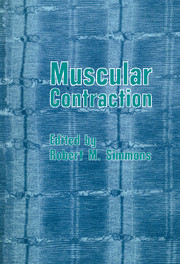Book contents
- Frontmatter
- Contents
- Dedication
- Contributors
- Preface
- 1 A. F. Huxley: an essay on his personality and his work on nerve physiology
- 2 A. F. Huxley's research on muscle
- 3 Ultraslow, slow, intermediate, and fast inactivation of human sodium channels
- 4 The structure of the triad: local stimulation experiments then and now
- 5 The calcium-induced calcium release mechanism in skeletal muscle and its modification by drugs
- 6 Hypodynamic tension changes in the frog heart
- 7 Regulation of contractile proteins in heart muscle
- 8 Differential activation of myofibrils during fatigue in twitch skeletal muscle fibres of the frog
- 9 High-speed digital imaging microscopy of isolated muscle cells
- 10 Inotropic mechanism of myocardium
- 11 Regulation of muscle contraction: dual role of calcium and cross-bridges.
- 12 Fibre types in Xenopus muscle and their functional properties.
- 13 An electron microscopist's role in experiments on isolated muscle fibres.
- 14 Structural changes accompanying mechanical events in muscle contraction.
- 15 Mechano-chemistry of negatively strained cross-bridges in skeletal muscle.
- 16 Force response in steady lengthening of active single muscle fibres.
- References
- Index
9 - High-speed digital imaging microscopy of isolated muscle cells
Published online by Cambridge University Press: 07 September 2010
- Frontmatter
- Contents
- Dedication
- Contributors
- Preface
- 1 A. F. Huxley: an essay on his personality and his work on nerve physiology
- 2 A. F. Huxley's research on muscle
- 3 Ultraslow, slow, intermediate, and fast inactivation of human sodium channels
- 4 The structure of the triad: local stimulation experiments then and now
- 5 The calcium-induced calcium release mechanism in skeletal muscle and its modification by drugs
- 6 Hypodynamic tension changes in the frog heart
- 7 Regulation of contractile proteins in heart muscle
- 8 Differential activation of myofibrils during fatigue in twitch skeletal muscle fibres of the frog
- 9 High-speed digital imaging microscopy of isolated muscle cells
- 10 Inotropic mechanism of myocardium
- 11 Regulation of muscle contraction: dual role of calcium and cross-bridges.
- 12 Fibre types in Xenopus muscle and their functional properties.
- 13 An electron microscopist's role in experiments on isolated muscle fibres.
- 14 Structural changes accompanying mechanical events in muscle contraction.
- 15 Mechano-chemistry of negatively strained cross-bridges in skeletal muscle.
- 16 Force response in steady lengthening of active single muscle fibres.
- References
- Index
Summary
Introduction
I remember Tuesday, February 25, 1964 as the day Andrew Huxley's boyhood hobby and long-standing interest in microscopy captivated my interest and thereafter strongly influenced my activities for the following 25 years. On that day, while I was still a graduate student, Andrew Huxley delivered the first of several lectures in the Jessup Lectureships at Columbia University. His topics included (1) “The Microscope Image of Striated Muscle”, (2) “Changes in the Striation Pattern during Contraction”, (3) “Past and Present Opinions on the Structure of the Muscle Fibre”, (4) “The Length-Tension Diagram of Striated Muscle”, (5) “The Inward Spread of Activation of Contraction”, and (6) “The Steps Between Electrical Activity and Contraction”. A leap of three and a half years brings us to August 29,1967, the day I began postdoctoral training in Andrew Huxley's laboratory at University College; on that date, he lent me his copy of Barer's “Lecture Notes on the Use of the Microscope”. In retrospect, these notes probably fixed an agenda that had first been proposed to me during those three weeks in 1964.
Compelling arguments for studying the contraction of fresh muscle fibres under the microscope had been made before and have been made since those lectures in 1964 (e.g., A. F. Huxley, 1977). However, light microscopy has found applications in many new areas of biological research in the past decade (Allen, 1986).
- Type
- Chapter
- Information
- Muscular Contraction , pp. 127 - 146Publisher: Cambridge University PressPrint publication year: 1992



